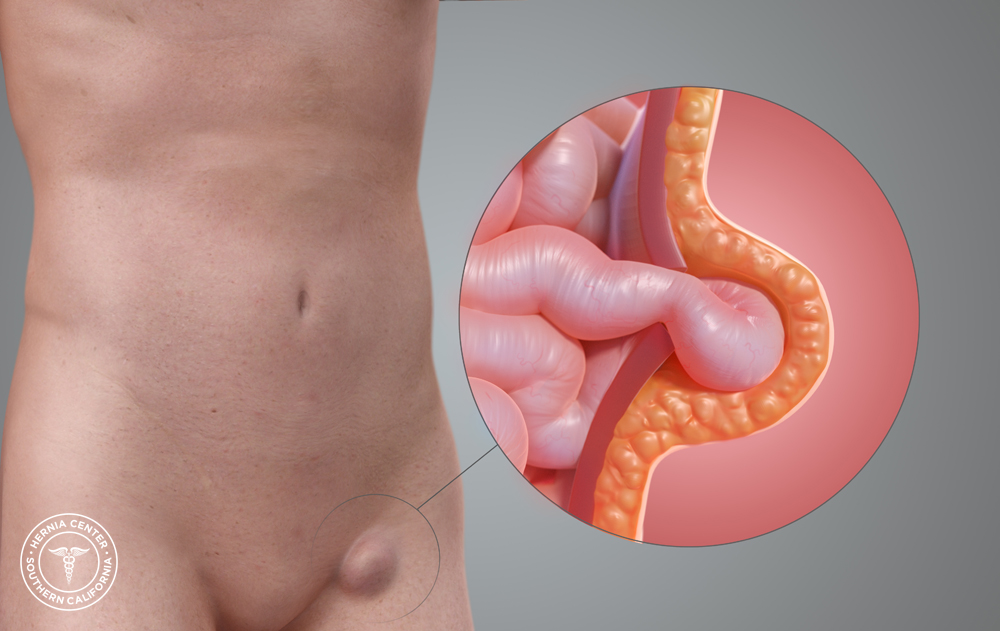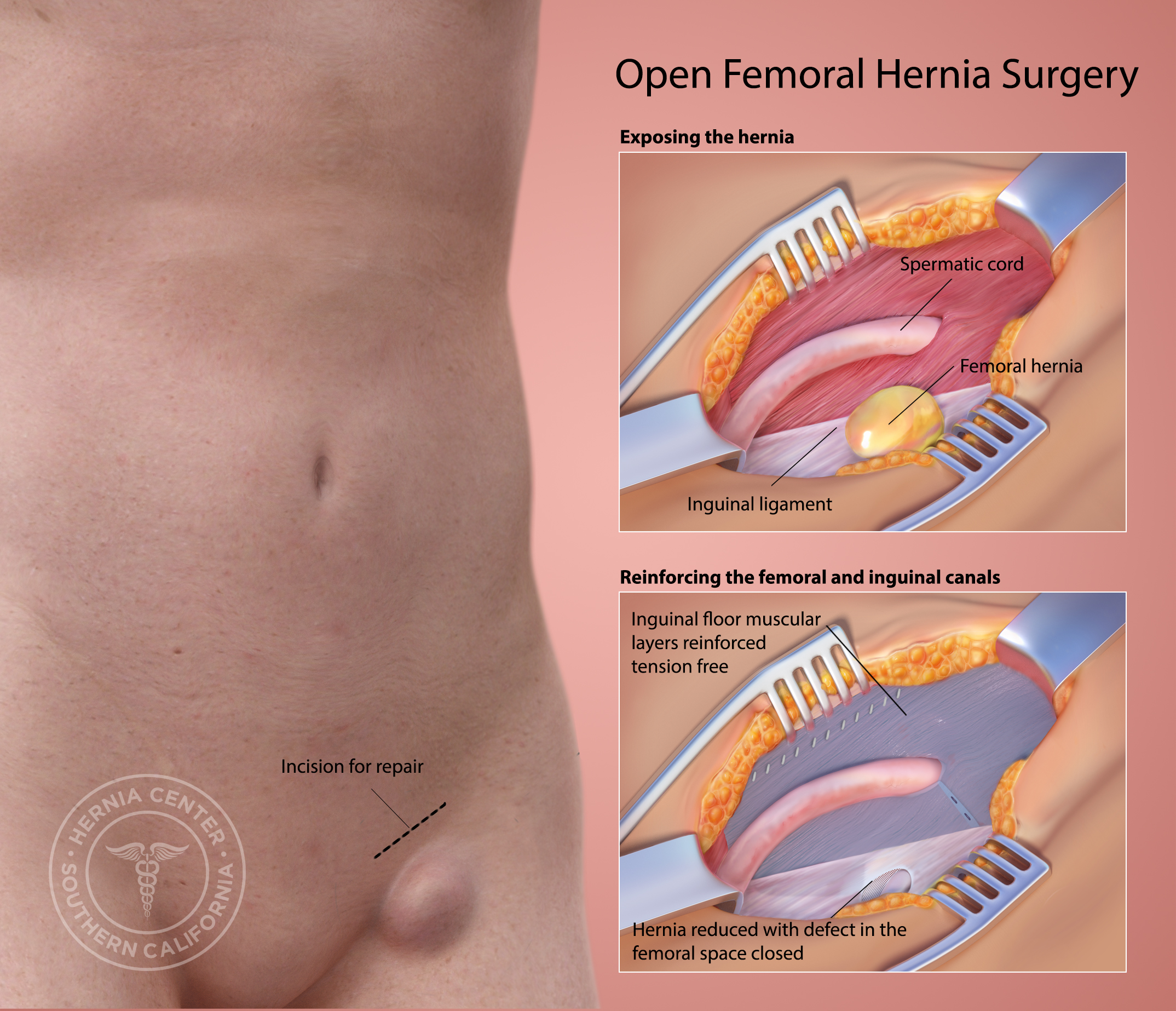COVID-19 ProtocolsLearn More
Covid-19 Safe Environment - CDC Guidelines In Place - Learn MoreBook Release Announcement - The Hernia Solution, 2nd Edition - Click here for more information
Need help? Call us 626.584.6116
Femoral hernias occur when a part of intestine, or other abdominal contents, is forced through a weakness in the “femoral canal.” The femoral canal is located near the groin and below the inguinal ligament, which is the crease between the lower abdomen and thigh. Part of the intestine, or other abdominal contents, is more likely to protrude through the femoral canal if a weakness already exists. Although femoral hernias are common in males, they are more likely to occur in females.

A femoral hernia is typically diagnosed by a surgeon on physical examination. Since the difference between femoral and inguinal hernias is so slight, it is often difficult to tell the two apart and often times a hernia surgeon is needed to make a proper diagnosis. It is possible to have both an inguinal and femoral hernia at the same time. In some cases X-ray such as a CT scan is utilized to diagnose a femoral hernia.
Certain activities, such as straining or coughing, that may increase pressure on the abdomen can also trigger a femoral hernia. Femoral hernias can also develop as a result of:
The most common symptom of a femoral hernia is a painful bulge in the groin. A femoral hernia may be “reducible” if the hernia can be pushed back into the abdomen manually. Usually, however, this is not the case and if the hernia becomes stuck in the femoral canal it is irreducible or incarcerated. This is a possibly dangerous condition in that the blood supply traveling to the herniated tissue can become pinched within the canal, in turn cutting off the oxygen and nutrients to the area. This is known as a strangulated femoral hernia, which often results in emergency surgery in order to free the pinched tissue and return regular blood flow to this area. An incarcerated or strangulated femoral hernia is often very painful and tender when touched. Nausea, vomiting and severe abdominal pain are also symptoms of a strangulated or incarcerated femoral hernia.
A femoral hernia is more likely to develop early complications, like strangulation or incarceration. Early diagnosis and repair is highly recommended before such complications can occur. As with their similar counterpart the inguinal hernia, a femoral hernia is well suited to our advanced “tension free” mesh repair techniques. At the Hernia Center of Southern California we practice the “tension free” mesh technique as it is the safest, most effective way to repair a femoral hernia.


In most cases, femoral hernia repair is performed under a local anesthesia with sedation. With the “tension free” Albin technique, we are able to tailor surgery more to the individual by selecting appropriate mesh for the shape, size and location of the individual hernia. As each of you in a unique individual, so is your femoral hernia. We understand there is no such thing as “one size fits all” and your femoral hernia shouldn’t be handled by any type of less effective approach. The basis behind our “tension free” approach is not to create unnatural tension – where it so obviously failed before – by cutting and sewing muscles into new places, but rather to avoid tension entirely.
Support and reinforcement to the surrounding tissue is provided by making effective use of sterile, flexible polypropylene mesh. We are able to effectively repair primary and recurrent femoral hernias. The mesh acts almost like a scaffolding as it assists the new tissue growth and incorporates itself safely and easily into the abdominal wall. Incredibly flexible and thin, you are unable to feel the mesh and it does not inhibit activity at all after femoral hernia surgery. Extending beyond the edges of the original weakness or tear, the mesh also supports the weak, thin tissue surrounding the hernia where it is most effective and will not lift or separate later with strenuous physical activity or excessive abdominal strain.
We have perfected our surgical techniques in such a way that we are even able to test and maximize the strength of the femoral hernia repair before surgery is complete. Our proprietary methods enable you to return to everyday activity quicker and we guarantee surgery FOR LIFE. Not only that, but our surgical methods are:
Understanding your unique situation and needs is first and foremost for us at the Hernia Center of Southern California, which is why we don’t perform one type of procedure of everyone, but rather choose methods best suited to you. Our philosophy carries over into our surgical techniques allowing us to specially repair your femoral hernia in a way best suited to our hernia specialists findings during surgery. We offer our advanced surgical techniques to you with the reassurance you are receiving the best possible care and repair for your femoral hernia. Since our techniques are “tension free” your risk of post-operative pain, problems and recurrence is extremely low and you can rest assured you will be returning to your regular, everyday activities with fewer restrictions, quicker.
Dr. Albin is a well recognized expert in femoral hernia repair. The Hernia Center of Southern California specializes in all types of advanced open and laparoscopic hernia surgery. His surgical practice is limited to the diagnosis and treatment of hernias. He is truly the hernia specialist. Patients see Dr. Albin from Los Angeles, Orange County, Riverside, San Bernardino and San Diego Counties as well as throughout the United States. The Albin Tension Free Mesh Technique is recognized worldwide.